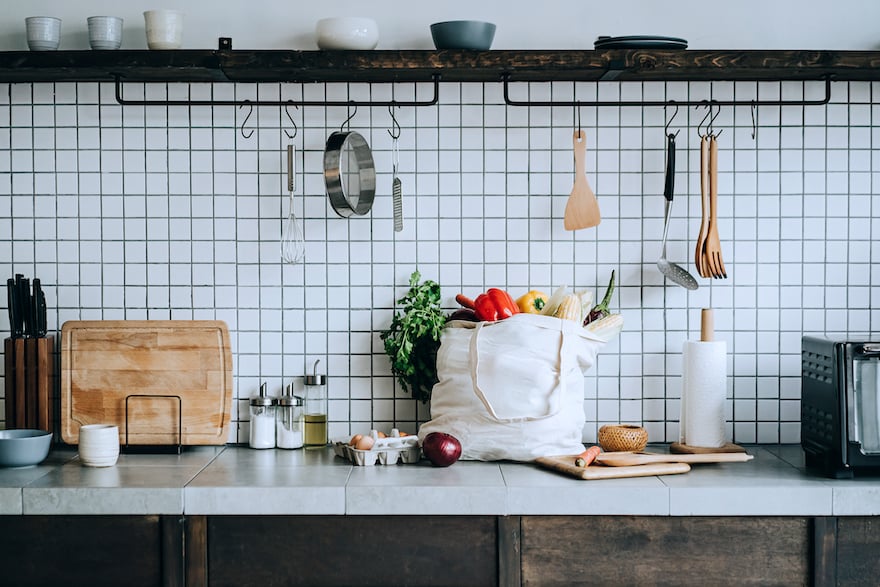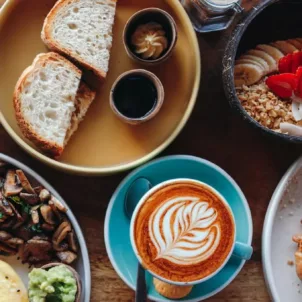‘I’m an RD And I Hate to Cook — Here’s How I Stay Healthy.’
If you don’t like working in the kitchen, you don’t have to give up on nutrition. Samaria Grandberry, MS, RDN, LDN, gives her best advice on how to eat healthy without cooking.
Hate to cook? You’re in good company. Even registered dietitians—who live and breathe food and nutrition all day—don’t always love spending hours in the kitchen.
That said, the alternative to not cooking doesn’t have to be a take-out order or packaged meal (both of which can often be laden with extra sodium, unhealthy fats, and preservatives).
To prove it, we tapped one of HUM Nutrition’s registered dietitians, Samaria Grandberry, MS, RDN, LDN—who prefers to spend her time outside the kitchen for her top healthy eating tips for the cooking averse. Get the scoop on how she sticks with easy, low-commitment recipes and no-cook meals to eat healthy without cooking.
The Formula For a Balanced Meal

The first question Samaria Grandberry, MS, RD, asks herself when putting together a meal is: What sounds good?
“I think it’s important to pay attention to your cravings,” she explains. “When you ignore them, that’s when you see people having ‘cheat days,’ or binging on things they don’t really want to eat because they’ve restricted themselves too much.”
From there, this is Grandberry’s foolproof formula for a healthy, satisfying meal:
1. Protein
Grandberry searches her freezer for foods that provide plenty of protein, which will help keep you full. “Since I don’t cook that much, I often buy fresh meats in bulk, portion, and freeze them,” she says. Grandberry recommends grass-fed, organic meat from a local farmer if that’s accessible to you. If you don’t eat meat, she suggests getting your protein from beans, eggs (if you’re not vegan), and whole grains like quinoa and millet.
High-protein foods like meat provide valuable nutrients—like B vitamins—that are tough to find in other places, Grandberry says. Vitamin B12, for example, helps make DNA and keeps your blood and nerve cells healthy, according to the National Institutes of Health (NIH). You can find this nutrient in fish, meat, eggs, milk, and fortified breakfast cereals. Since only animal products have vitamin B12 naturally, vegans and vegetarians may not get enough of this nutrient from diet alone. Dietary supplements, like HUM Nutrition’s B12 Turbo, can help fill in some gaps.
2. Fiber
Meanwhile, fiber-rich foods like veggies and whole grains are essential for gut and total-body health. For fiber, Grandberry uses frozen vegetables like broccoli, corn, peas, and green beans.
According to the Mayo Clinic, dietary fiber helps ensure regular bowel movements, keep blood sugar and cholesterol levels under control, lower blood pressure, and may even reduce your risk of dying from heart disease.
But for all the good fiber does, most Americans don’t get enough. In fact, research published in the American Journal of Lifestyle Medicine shows that only five percent of Americans get the recommended 19 to 38 grams (g) of fiber per day. By building every meal around high-fiber foods, you can increase your odds of reaching your recommended daily intake.
3. Grains
Carbohydrates are our bodies main source of energy, which means they’re a crucial part of any meal. (Added bonus: Many grains are high in dietary fiber too.)
Grandberry tries to include a grain at lunch and dinner by reaching for brown rice, millet, quinoa, and bulgur. She sometimes incorporates whole grains into her breakfast, using whole-grain bagels, granola, or oatmeal.
By incorporating grains, fiber, and protein, Grandberry is able to create a plate that’s both satisfying and nutritious. “Basically, I follow my cravings, and then I try to build the most filling, colorful, fast meal I can using the aforementioned principles,” Grandberry says. Speaking of color, that’s another principle she follows: Aim to get at least 2 to 3 different colors on your plate per meal.
Tips For Hitting The Grocery Store

Healthy, easy meals often start with grocery store trips. Here are Grandberry’s must-dos when shopping for food.
- Stock up on frozen produce. Frozen fruits and vegetables last longer than their fresh counterparts but still offer nutritional value, Grandberry says. Plus, they don’t typically require washing or cutting, which speeds things up when preparing meals.
- Go plain. Pick frozen fruits and vegetables that haven’t been seasoned or mixed with sauce. This way, you’ll get vitamins and minerals without any added sodium, sugar, or calories. She also loves veggie mixes—like bell pepper and onion combo—because they make it easy to add a variety of vegetables to one dish.
- Spice things up. One of the best ways to upgrade your meals with minimal effort is to season your food. Spices and dried herbs can make a big impact on the overall taste of your food. Plus, there are some serious health benefits to using spices and herbs while cooking. A study found that spices and herbs possess antioxidant, anti-inflammatory, and anti-carcinogenic properties. Additionally, they can lower glucose and cholesterol levels and have properties that can affect cognition and mood. Pick up some popular seasonings like chili pepper, cinnamon, ginger, black pepper, turmeric, fenugreek, rosemary, and garlic.
- Get some fresh stuff. While the bulk of Grandberry’s fruits and vegetables come from the freezer section, she still gets a few fresh items like a bag of pre-cut salad greens, apples, onions, and any seasonal produce she might be craving. “Seasonal produce tends to be cheaper and always tastes better,” Grandberry says.
- Opt for frozen meat. Frozen meat is easy to store and cook, which means it usually makes its way into Grandberry’s shopping cart. Great options include seasoned salmon and tilapia filets, shrimp, ground chicken, and turkey. You can also pick up plain chicken or lean beef from the meat counter and do some prep work at home: Season the meat, cut it into chunks, and store it in the freezer.
- Buy foods that require minimal prep. Pre-sliced bread and bagels, snack nuts, eggs, yogurt cups, and plain popcorn are great grab-and-go foods.
Tips For Eating Out

Some days can get so hectic that it’s just easiest to swing through the drive-thru for breakfast or grab a mobile order from your favorite lunch spot. But rest assured, you can still score a nutritious meal when eating out. Just keep these tips from Grandberry in mind.
- Look for options with fiber. Salads, whole-grain sandwich bread, steamed vegetables and oatmeal are all high-fiber foods that fill you up with fewer calories per serving than low-fiber options.
- Go for grilled. When you have the option, choose foods that have been grilled instead of fried. Fried foods tend to be higher in calories and saturated fat.
- Get it in a wrap. Some restaurants offer their standard sandwiches as a wrap. If that’s the case, consider swapping out your bread for a whole-grain tortilla. You’ll still get fiber but cut down on calories.
What I Eat In a Day: A Cooking-Averse Dietitian

Not everyone has the time (or desire) to batch cook, meal prep, or look up the perfect recipe. If you don’t particularly love spending time in the kitchen, there are still ways to eat healthily. Grandberry, for example, doesn’t like to spend too much time putting together dishes but is able to maintain a balanced, healthy diet. Here’s what a typical day of eating looks like for her.
Breakfast
“I typically like to have coffee in the morning with some type of protein like eggs and a whole grain like toast or a bagel,” Grandberry says. Some days, she prefers an easy breakfast parfait of vanilla Greek yogurt, granola, and sliced strawberries.
Lunch
Lunch is typically Grandberry’s biggest meal of the day. “I usually make some type of dish at the beginning of the week and eat leftovers,” she says. A couple of her latest lunches include a salad topped with grilled chicken, and white pasta with store-bought pesto sauce, shrimp and veggies. While whole-grain pasta offers more fiber, Grandberry prefers the taste and texture of refined pasta. (And she believes it’s better to eat foods you actually enjoy, rather than forcing yourself to eat healthier variations of the same foods.) To cut down on prep and cooking time, she uses frozen meats and veggies.
Dinner
Like lunch, Grandberry typically whips up a quick dinner recipe to last the entire week. One of her go-to dinners is ground turkey, quinoa, frozen kale and roasted sweet potatoes. To make the potatoes, she cuts up some fresh spuds and tosses them in olive oil. Then, she sprinkles them with cinnamon, nutmeg and a touch of brown sugar and pops them in the oven for an hour. “I like things I can put in the oven or on the stove and then go do something else for a while,” Grandberry says. Crockpots and air fryers are other handy kitchen tools for people who hate to cook, she adds.
Snacks
When Grandberry needs a quick bite, she often pairs fiber-rich fruit like apples and berries with a fat and protein source like peanut butter. Almonds, cheese, and popcorn are her other go-to’s.
Bottom Line
Eating healthy doesn’t mean your life has to revolve around cooking. By keeping your kitchen stocked with quick-prep foods and building most meals around protein and fiber, you can eat healthy with minimal kitchen time.











